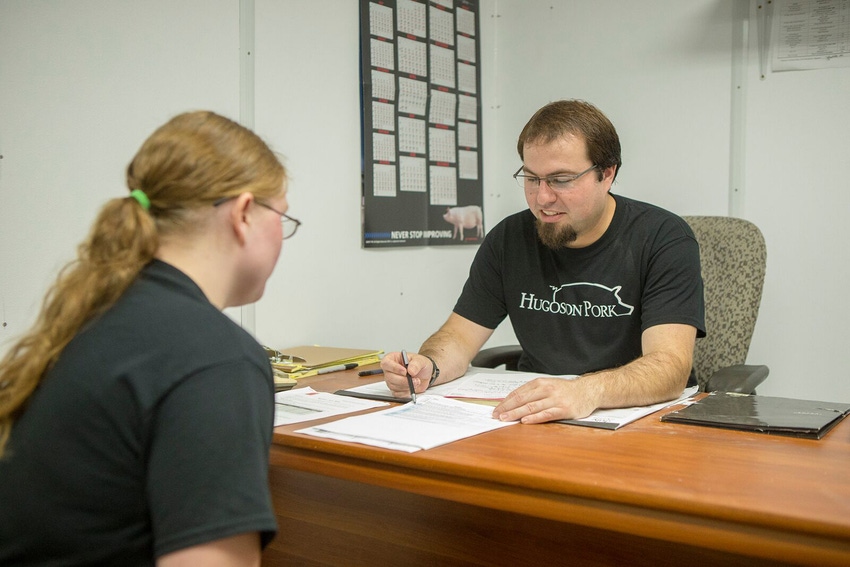Being short-handed doesn’t have to be industry norm
Getting your new team members off to a great start begins during orientation and onboarding.
October 9, 2019

By Samantha Marais, Swine Safety Designs
We’ve been short on help for months. You haven’t had a day off in weeks. It’s 2 o’clock on a Wednesday afternoon. You’ve been up since 4 a.m. for loadout. After shipping, you and the team sorted market loads for the following morning, pulled an auger, got the feed system put back together, recycled pits, treated all barns, got bin readings, filled out daily reports and completed all paper work.
You’re on your fifth cup of coffee which has doubled as nourishment today, so you throw a cheese stick and a piece of jerky on the counter so you can eat on the drive. You showered out to head to the office for an interview. You arrive, make small talk with the office staff while waiting for the arrival, annoyed, beat and cussing the applicant (in your head, of course) because they’re late for the 2 p.m. interview time, that was agreed upon a week ago. Finally, at 2:17 they stroll in, bed head, wearing a T-shirt, pajama pants and flip flops.
This is a real-life experience in the day of a swine production leader. I’ve been there. It’s the pig farmer’s version of Deana Carter’s “Did I Shave My Legs For This?” My brain just screams “are you freaking kidding me?” Nevertheless, I greet the applicant with a smile and handshake, inviting them to join myself and our human resources representative in the interview room.
Above all else, I know it’s important to maintain a professional yet welcoming atmosphere, regardless of the applicant. Does that mean we’re going to offer Mr. Bedhead a position? Not likely! We are going to treat him with respect, because that is our company culture. Finding, then keeping, quality applicants takes strong leadership, hard-work, persistence and an open mind. I’d like to share a few pointers to help you ease the entire hiring process.
Let’s start with a question. Do you know the difference between orientation and onboarding? Orientation is the act or process of orienting or of being oriented. Orientation begins at first contact with the applicant, before being hired. It sets the stage for their entire potential career with you. From a company stand point, orientation introduces the applicant or new hire to the company. Often times this is when new-hire paperwork is completed.
Onboarding is the act or process of training a new employee in their position. Onboarding may include orientating your new teammate to the company expectations, setting performance goals — such as learning how to give shots properly, spotting sick pigs, learning what biosecurity is and how to follow biosecurity protocols, etc. Onboarding in the pork industry is the hands-on training. Once you decipher the difference, ask yourself “are we using both to their full potential to land and keep qualified applicants?”
Statistically speaking, a report published by Gallup states only 12% of employees strongly agree that their organization does a great job onboarding new hires. Twelve percent?!?! To be frank, that number should be an embarrassment to leaders everywhere. This downfall gets in the way of potentially forming an emotional bond between the new hire and your company — a connection that can make or break retention. Another study conducted by the Society for Human Resource Management, employee turnover can be as much as 50% in the first 18 months of employment. This means that across all industries, companies need to be more active and diligent during orientation and onboarding.
A golden rule to stand by while interacting with an applicant is “don’t write a check that you can’t cash.” Keep your word. It should be simple, but it happens more often than you’d think. Don’t promise them anything you may not be able to fulfill.
What is your first impression to potential hires? Offer them a taste of your professional, welcoming, team-oriented atmosphere. Do you provide access to necessary tools to your HR department? Swine Safety Designs creates short position description videos ready for use during the interview. Using video format gives you an excellent visual aid for each applicant. They’ll know whether or not they can handle the position if they see it in action.
Do you clearly outline both orientation and onboarding so they know what to expect? For example, “Your paid orientation with us is here at the office. At that time, we will have you complete a drug test, tax paperwork, sign your negotiated wage package, go over our employee handbook and discuss our company culture. We’ll take you to lunch at the diner in town and end the day with a visit to the farm for a tour and introduce you to the rest of your team. During onboarding we complete 30-, 60- and 85-day reviews. During your review we talk about your performance, any accomplishments you’ve had, set goals for the next review and give you the opportunity to talk to us. Once you’re settled in, we do an annual review of all of our team members. You are encouraged to bring up any victories or concerns you have. All feedback during reviews is confidential.”
Not all producers will have this exact set-up. Tailor it to your needs, however, having a structured outline will accomplish these five goals.
Turn your first impression from typical to great. First impressions inspire action from applicants, let’s make them want to work for the farm. Get them excited to be working for a company that welcomes and will appreciate what they bring to the table. The difference between an applicant who wants to work for you or one who needs to work for you is an attitude that will carry over to employee performance.
Weed out applicants that you know won’t be a good fit for your company. They’ll know that they can’t handle sleeving sows or stomach the smell of snaking out a pit. Visual aids are a much better presentation than a verbal description. This saves you from investing in “30-day wonders,” therefore, lowering your turnover rates.
Before offering them a position, be confident that the applicant understands the job description. This specific step is the most crucial, unfortunately, it’s the most likely to be skipped over due to workforce demands. After they’ve observed the position in action, allow them to ask questions. Applicants are thrown into positions that they have no interest in simply because that’s where the opening was on the farm. Doing this sets the applicant up to fail. It’s not beneficial to you or them.
Streamline the entire hiring process. Be ready for them. It’s to your advantage to have sets of interview questions that complement each position. You’ll be able to tailor the interview for the position that best fits the applicant. One set of questions does not fit all positions. Prepare and have all orientation packets completed prior to the new hire’s arrival. Interviewing, negotiating wage packages, hiring and introductions should never seem like a chore. Never appear unorganized to potential team members.
Be understanding that no two applicants are the same. You may set a timeline for certain performance goals, but always allow wiggle room. By having an outline readily available to them, they’ll have a clear expectation about their onboarding experience. If they don’t meet a goal, do not blame the trainee. As a trainer, ask “what do I need to do differently to help them learn?”
Finding good help is hard enough. Let’s do our best to be an industry that appreciates existing employees and attracts quality applicants. A little preparation goes a long way with potential hires. Lead by example, be a hard worker, be patient, be humble, be kind, be understanding, be honest. Be the leader that you’d want to have guiding you through a hiring process that you’d want to experience.
Source: Samantha Marais, Swine Safety Designs, who is solely responsible for the information provided, and wholly owns the information. Informa Business Media and all its subsidiaries are not responsible for any of the content contained in this information asset.
You May Also Like



